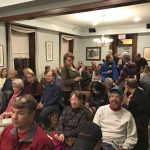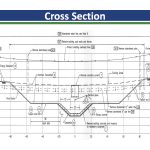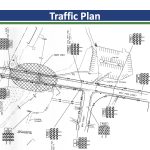Broomall’s Dam Removal
With Broomall’s Dam scheduled to be partially removed in the near future, we thought it was relevant to provide an in-depth recap of the February meeting with the PA Department of Environmental Protection (DEP), who will be managing the planned breach.
 On February 22, about 100-150 people crowded into the Media Borough Parlor Room to meet with officials from the PA Department of Environmental Protection (DEP) to discuss the planned partial breach of Broomall’s dam in late April.
On February 22, about 100-150 people crowded into the Media Borough Parlor Room to meet with officials from the PA Department of Environmental Protection (DEP) to discuss the planned partial breach of Broomall’s dam in late April.
After some time to look over the technical plans and respond to residents’ questions, the DEP presented the why’s and how’s of the removal of Broomall’s Dam for safety reasons. Roger Adams, Division Chief of Dam Safety, gave a compelling presentation of the dangers to human life and property when a dam fails. Examples include the Bayless Dam, in which 10” of rain caused a catastrophic failure.
High hazard dam in poor condition
Of the 3,371 dams in Pennsylvania, only 754 are high hazard dams. While Broomall’s Dam is smaller than large dams like the Youngstown Dam, it is still categorized as a High Hazard C-2 dam, based on the amount of water and sediment held back and the height. It is also a High Hazard dam in poor condition. Even if the dam is rebuilt, it will again be a High Hazard C-2 dam.
Broomall’s an orphan dam that is deteriorating
Duke Adams (no relation to Roger), took up the presentation and discussed the issues around ownership. The dam was built in 1883 by John Broomall for ice harvesting. In 1980 the Army Corps of Engineers found the dam to be structurally in poor condition. In 1996 the roadway was closed for safety reasons. No party, not Broomall’s Lake Country Club (BLCC), Media Borough or Delaware County have been willing to take up the maintenance responsibilities over this time. The DEP has considered Broomall’s Dam an “orphan dam” because of the lack of responsible or willing owner.
In June 2014, Delaware County, BLCC and Media Borough signed a stipulation and order. Duke Adams explained that this order means that Media Borough would manage the reconstruction of the dam, and Delaware County would take ownership of the downstream face, and BLCC would be the owner and responsible party for the upstream face.
In 2012, BLCC sued Media Borough over its plan for a one-lane compromise for the bridge — a solution that was supported by borough residents, Friends of Glen Providence Park, and the majority of Borough Council. Shortly thereafter the dam began to deteriorate significantly, with entire pieces of wall crumbling on the upstream and downstream side. The DEP elected to lower the water level to its absolute minimum in June 2013, and when the lake level was not maintained, the DEP returned and lowered it again in March 2016.
Eliminate the hazard
However, due to continual delays and a lack of clarity of an owner (none of the three parties has stepped forward and take responsibility to date), the DEP has decided to eliminate the hazard of the dam. By removing nearly all of the standing water and a significant amount of liquid sediment, the pressure on the dam walls will be reduced. The hazard category will be lowered to C-4. Their presentation highlighted the dangers of allowing high hazard dams to remain in place.
Work begins in early May
The work on the dam will begin around May 9th and should conclude within two months. During construction, the entire corner of 3rd and West Street will be closed to all traffic and the entrance to BLCC swim club will be closed, to reopen once the partial breach is complete.
The main spillway of the dam will be removed, as will the waterfall. Broomall’s Lake will drain almost completely and construction access into the lake will remain until the dam is reconstructed. The original stream of Broomall’s Run will find its own course and several springs that feed into Broomall’s Lake may make their appearance.
The DEP reported that before dam removal begins, up to two weeks will be spent to remove the PA Threatened Northern Redbelly Turtle (Pseudemys rubriventris) and native snapping turtles, which will be relocated to the pond in Glen Providence Park. The invasive Red-eared slider (a similar looking turtle) will be removed and donated to science programs. Other fish, frogs and invertebrates will have to find their way during the draining of the lake or they will perish. Traps to capture turtles were set on April 24th.
Loss of pedestrian and bicycle access for Upper Providence for 2 years or more
The likely reason why so many people came to the meeting was due to the disruption of pedestrian and bicycle access across the dam starting at the end of April, and lasting until the proposed dam reconstruction. Roger Adams could not say how long the period between dam removal and dam reconstruction would be, but did not hesitate to say at least two years. (The dam reconstruction permit has not been approved or scheduled to date.)
There were a number of questions from the audience on the issue, particularly focused on Upper Providence residents who use Third Street frequently to walk into Media. Safety issues were also raised by residents, particularly the concern that if there were no access at all, some daring individuals would somehow find a way that would most likely be very unsafe. The DEP indicated that there might be a possibility of installing a temporary pedestrian bridge.
Stream Restoration
A benefit of dam removal is the re-establishment of open waterways and natural streams. Artificial dammed bodies of water not only present a hazard of failure on the downstream side, but they also hold back aquatic life and sediment that contribute to the overall health of our waterways.
Pedestrian Bridge
A coalition of Upper Providence and Media neighbors and Friends of Glen Providence Park is working to establish a temporary pedestrian footbridge to maintain the connection between Media and Upper Providence in the time period between dam removal and dam reconstruction. The proposed footbridge is modular and can be relocated into Glen Providence Park at one of the former bridge sites once dam reconstruction begins. If you are interested in supporting this effort, please contact us.













Thank you for the information. Noticing that the water is extremely high these days, I am concerned for the safety of the people who drive across the damage and for those who live down stream.